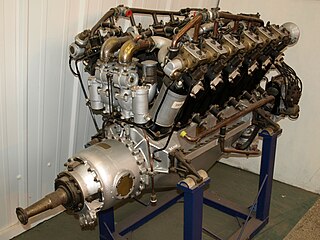
The de Havilland Gipsy Major or Gipsy IIIA is a four-cylinder, air-cooled, inverted inline engine used in a variety of light aircraft produced in the 1930s, including the famous Tiger Moth biplane. Many Gipsy Major engines still power vintage aircraft types.

Major Frank Bernard Halford CBE FRAeS was an English aircraft engine designer. He is best known for the series of de Havilland Gipsy engines, widely used by light aircraft in the 1920s and 30s.
The Cirrus and Hermes or Cirrus-Hermes are a series of British aero engines manufactured, under various changes of ownership, from the 1920s until the 1950s. The engines were all air-cooled, four-cylinder inline types, with earlier ones upright and later designs inverted.

The Rolls-Royce Falcon is an aero engine developed in 1915. It was a smaller version of the Rolls-Royce Eagle, a liquid-cooled V-12 of 867 cu in capacity. Fitted to many British World War I-era aircraft, production ceased in 1927. The Falcon was designed by R.W. Harvey-Bailey.

The Rolls-Royce Condor aircraft piston engine is a larger version of the Rolls-Royce Eagle developing up to 675 horsepower. The engine first ran in 1918 and a total of 327 engines were recorded as being built.

The Armstrong Siddeley Cheetah is a seven-cylinder British air-cooled aircraft radial engine of 834 cu in capacity introduced in 1935 and produced until 1948. Early variants of the Cheetah were initially known as the Lynx Major.

The Armstrong Siddeley Jaguar is an aircraft engine developed by Armstrong Siddeley. The Jaguar was a petrol-fuelled air-cooled 14-cylinder two-row radial engine design. The Jaguar III was first used in 1923, followed in 1925 by the Jaguar IV and in 1927 by the Jaguar VI. In 1925 the Jaguar became the first production aero engine incorporating a geared supercharger.

The Armstrong Siddeley Lynx is a British seven-cylinder aero engine developed by Armstrong Siddeley. It was developed as a single row version of the two-row Armstrong Siddeley Jaguar. Testing began in 1920 and 6,000 had been produced by 1939. In Italy Alfa Romeo built a 200 horsepower (150 kW) licensed version of this engine named the Alfa Romeo Lynx.

The Armstrong Siddeley Mongoose is a British five-cylinder radial aero engine produced by Armstrong Siddeley. Developed in the mid-1920s it was used in the Hawker Tomtit trainer and Parnall Peto seaplane amongst others. With a displacement of 540 cubic inches (9 litres) the Mongoose had a maximum power output of 155 horsepower (115 kilowatts).

The de Havilland Gipsy Queen is a British six-cylinder aero engine of 9.2 litres (560 cu in) capacity that was developed in 1936 by the de Havilland Engine Company. It was developed from the de Havilland Gipsy Six for military aircraft use. Produced between 1936 and 1950 Gipsy Queen engines still power vintage de Havilland aircraft types today.

The de Havilland Gipsy is a British air-cooled four-cylinder in-line aircraft engine designed by Frank Halford in 1927 to replace the ADC Cirrus in the de Havilland DH.60 Moth light biplane. Initially developed as an upright 5 litre capacity engine, later versions were designed to run inverted with increased capacity and power.

The Armstrong Siddeley Genet Major is a British five-cylinder, air-cooled, radial engine for aircraft, designed and built by Armstrong Siddeley and first run in 1928. It developed 140 horsepower (104 kW). In Royal Air Force use the seven-cylinder version was known as the Civet I. The Feliform names used are in line with company convention, the Genet and Civet both being large cat-like carnivores.

The Blackburn Cirrus Major is a British, inline-four aircraft engine that was developed in the late 1930s.

The Armstrong Siddeley Genet is a five-cylinder, air-cooled, radial engine for aircraft use built in the UK, first run in 1926. It developed 80 hp at 2,200 rpm in its final form and was a popular light aircraft powerplant. Following the company tradition with a slight deviation the engine was named after the Genet, a catlike animal of the same order but different family.

The Napier Rapier was a British 16-cylinder H pattern air-cooled aero engine designed by Frank Halford and built by Napier & Son shortly before World War II.

The ADC Cirrus is a series of British aero engines manufactured using surplus Renault parts by the Aircraft Disposal Company (ADC) in the 1920s.

The de Havilland Gipsy Minor or Gipsy Junior is a British four-cylinder, air-cooled, inline engine that was used primarily in the de Havilland Moth Minor monoplane, both products being developed in the late 1930s.

The Blackburn Cirrus Bombardier was a British four-cylinder inline aircraft engine, developed and built by the Blackburn Aircraft company in the mid-1950s. The engine featured fuel injection.
The ADC Nimbus was a British inline aero engine that first ran in 1926. The Nimbus was developed from the Siddeley Puma aero engine by Frank Halford of the Aircraft Disposal Company, the goal was to develop the Puma to produce its intended power output which Halford eventually achieved. The Nimbus was further developed into an air-cooled version known as the ADC Airsix which did not enter production and was not flown.
The de Havilland Ghost was a British V-8 aero engine that first ran in 1928.

















